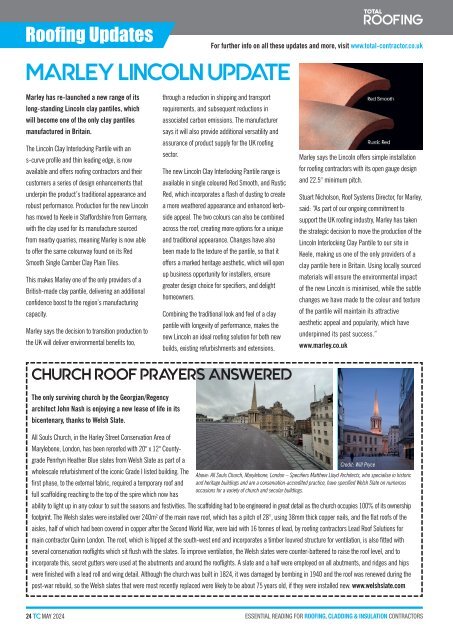May 2024
You also want an ePaper? Increase the reach of your titles
YUMPU automatically turns print PDFs into web optimized ePapers that Google loves.
Roofing Updates<br />
MARLEY LINCOLN UPDATE<br />
For further info on all these updates and more, visit www.total-contractor.co.uk<br />
Marley has re-launched a new range of its<br />
long-standing Lincoln clay pantiles, which<br />
will become one of the only clay pantiles<br />
manufactured in Britain.<br />
The Lincoln Clay Interlocking Pantile with an<br />
s-curve profile and thin leading edge, is now<br />
available and offers roofing contractors and their<br />
customers a series of design enhancements that<br />
underpin the product’s traditional appearance and<br />
robust performance. Production for the new Lincoln<br />
has moved to Keele in Staffordshire from Germany,<br />
with the clay used for its manufacture sourced<br />
from nearby quarries, meaning Marley is now able<br />
to offer the same colourway found on its Red<br />
Smooth Single Camber Clay Plain Tiles.<br />
This makes Marley one of the only providers of a<br />
British-made clay pantile, delivering an additional<br />
confidence boost to the region’s manufacturing<br />
capacity.<br />
Marley says the decision to transition production to<br />
the UK will deliver environmental benefits too,<br />
through a reduction in shipping and transport<br />
requirements, and subsequent reductions in<br />
associated carbon emissions. The manufacturer<br />
says it will also provide additional versatility and<br />
assurance of product supply for the UK roofing<br />
sector.<br />
The new Lincoln Clay Interlocking Pantile range is<br />
available in single coloured Red Smooth, and Rustic<br />
Red, which incorporates a flash of dusting to create<br />
a more weathered appearance and enhanced kerbside<br />
appeal. The two colours can also be combined<br />
across the roof, creating more options for a unique<br />
and traditional appearance. Changes have also<br />
been made to the texture of the pantile, so that it<br />
offers a marked heritage aesthetic, which will open<br />
up business opportunity for installers, ensure<br />
greater design choice for specifiers, and delight<br />
homeowners.<br />
Combining the traditional look and feel of a clay<br />
pantile with longevity of performance, makes the<br />
new Lincoln an ideal roofing solution for both new<br />
builds, existing refurbishments and extensions.<br />
Marley says the Lincoln offers simple installation<br />
for roofing contractors with its open gauge design<br />
and 22.5° minimum pitch.<br />
Stuart Nicholson, Roof Systems Director, for Marley,<br />
said: “As part of our ongoing commitment to<br />
support the UK roofing industry, Marley has taken<br />
the strategic decision to move the production of the<br />
Lincoln Interlocking Clay Pantile to our site in<br />
Keele, making us one of the only providers of a<br />
clay pantile here in Britain. Using locally sourced<br />
materials will ensure the environmental impact<br />
of the new Lincoln is minimised, while the subtle<br />
changes we have made to the colour and texture<br />
of the pantile will maintain its attractive<br />
aesthetic appeal and popularity, which have<br />
underpinned its past success.”<br />
www.marley.co.uk<br />
CHURCH ROOF PRAYERS ANSWERED<br />
The only surviving church by the Georgian/Regency<br />
architect John Nash is enjoying a new lease of life in its<br />
bicentenary, thanks to Welsh Slate.<br />
All Souls Church, in the Harley Street Conservation Area of<br />
Marylebone, London, has been reroofed with 20" x 12" Countygrade<br />
Penrhyn Heather Blue slates from Welsh Slate as part of a<br />
Credit: Will Pryce<br />
wholescale refurbishment of the iconic Grade I listed building. The<br />
Above: All Souls Church, Marylebone, London – Specifiers Matthew Lloyd Architects, who specialise in historic<br />
first phase, to the external fabric, required a temporary roof and and heritage buildings and are a conservation-accredited practice, have specified Welsh Slate on numerous<br />
occasions for a variety of church and secular buildings.<br />
full scaffolding reaching to the top of the spire which now has<br />
ability to light up in any colour to suit the seasons and festivities. The scaffolding had to be engineered in great detail as the church occupies 100% of its ownership<br />
footprint. The Welsh slates were installed over 240m 2 of the main nave roof, which has a pitch of 28°, using 38mm thick copper nails, and the flat roofs of the<br />
aisles, half of which had been covered in copper after the Second World War, were laid with 16 tonnes of lead, by roofing contractors Lead Roof Solutions for<br />
main contractor Quinn London. The roof, which is hipped at the south-west end and incorporates a timber louvred structure for ventilation, is also fitted with<br />
several conservation rooflights which sit flush with the slates. To improve ventilation, the Welsh slates were counter-battened to raise the roof level, and to<br />
incorporate this, secret gutters were used at the abutments and around the rooflights. A slate and a half were employed on all abutments, and ridges and hips<br />
were finished with a lead roll and wing detail. Although the church was built in 1824, it was damaged by bombing in 1940 and the roof was renewed during the<br />
post-war rebuild, so the Welsh slates that were most recently replaced were likely to be about 75 years old, if they were installed new. www.welshslate.com<br />
24 TC MAY <strong>2024</strong>
















